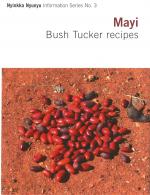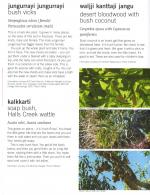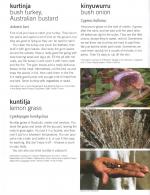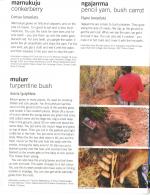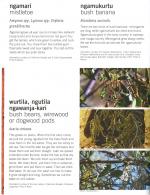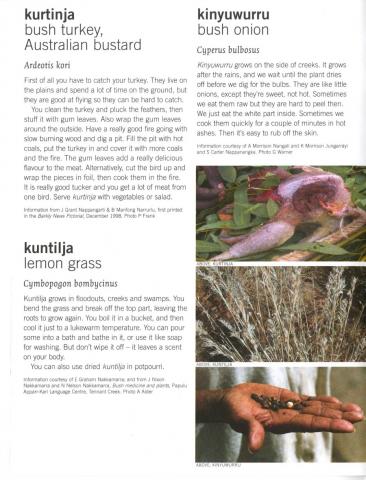Mayi: Bush Tucker Recipes (page 4)
kurtinja (bush turkey, Australian bustard; Ardeotis kori)
First of all you have to catch your turkey. They live on the plains and spend a lot of time on the gound, but they are good at flying so they can be hard to catch. You clean the turkey and pluck the feathers, then stuff it with gum leaves. Also wrap the gum leaves around the outside. Have a really good fire going with slow burning wood and dig a pit. Fill the pit with hot coals, put the turkey in and cover it with more coals and the fire. The gum leaves add a really delicious flavour to the meat. Alternatively, but the bird up and wrap the pieces in foil, then cook them in the fire. It is a really good tucker and you get a lot of meat from one bird. Serve kurtinja with vegetables or salad.
J. Grant Nappangarti & B Manfong Narrurlu, first printed in the Barkly Pictorial, December 1998. Photo P. Frank
kuntilja (lemon grass; Cymbopogon bombycinus)
Kuntilja grows in floodouts, creeks and swamps. You bend the grass and break off the top part, leaving the roots to grow again. You boil it in a bucket, and then cool it to just be lukewarm temperature. You can pour some into a bath and bathe in it, or use it like soap for washing. But don't wipe it off - it leaves a scent on your body. You can also use dried kuntilija potpourri.
E. Graham Nakkamarra; and from Nixon Nakkamarra and N. Nelson Nakkamarra, Bush medicine and plants, Papulu Apparr-Kari Language Centre, Tennant Creek. Photo A. Alder
kinyuwurru (bush onion; Cyperus bulbosus)
Kinyuwurru grows on the side of creeks. It grows after the rainsand we wait until the plant dries off before we dog for the bulbs. They are like little onions excepts they're sweet, not hot. Sometimes we eat them raw but they are hard to peel then. We just eat the white part inside. Sometimes we cook them quickly for a couple minutes in hot ashes. Then it's easy to run off the skin.
A. Morrison Nangali and K. Morrison Jungarrayi and S. Carter Nappanangka. Photo by G. Warner
